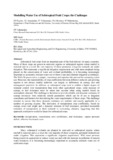Please use this identifier to cite or link to this item:
https://cris.library.msu.ac.zw//handle/11408/3830| Title: | Modelling water use of subtropical fruit crops: the challenges | Authors: | Taylor, N.J Annandale, J.T Vahrmeijer, J.T Ibraimo, N.A Mahohoma, W Gush, M.B Allen, R.G #PLACEHOLDER_PARENT_METADATA_VALUE# #PLACEHOLDER_PARENT_METADATA_VALUE# #PLACEHOLDER_PARENT_METADATA_VALUE# #PLACEHOLDER_PARENT_METADATA_VALUE# #PLACEHOLDER_PARENT_METADATA_VALUE# #PLACEHOLDER_PARENT_METADATA_VALUE# #PLACEHOLDER_PARENT_METADATA_VALUE# |
Keywords: | transpiration transpiration crop coefficients leaf resistance vapour pressure deficit effective fractional cover |
Issue Date: | 2017 | Publisher: | nternational Society for Horticultural Science | Series/Report no.: | nternational Society for Horticultural Science;SHS Acta Horticulturae 1160: X International Symposium on Modelling in Fruit Research and Orchard Management | Abstract: | Subtropical fruit crops form an important part of the fruit industry in many countries. Many of these crops are grown in semi-arid regions or subtropical regions where rainfall is seasonal and as a result the vast majority of these perennial, evergreen orchards are under irrigation. This represents a significant irrigation requirement and with more emphasis being placed on the conservation of water and orchard profitability, it is becoming increasingly important to accurately estimate water use of these crops and schedule irrigation accordingly. The FAO-56 procedure is a simple, convenient and reproducible method for estimating water use. However, the transferability of crop coefficients between different orchards and growing regions is not always readily achieved, due largely to differences in canopy size and management practices. In addition, as subtropical crops tend to exhibit a higher degree of stomatal control over transpiration than most other agricultural crops, some measure of canopy or leaf resistance must be taken into account when using models based on atmospheric demand. The challenge is therefore to provide reliable and dynamic estimates of canopy resistance from relatively simple parameters which can be of use to irrigation consultants and farmers for determining the water requirements of these crops. The challenge remains to ensure that these dynamic estimates are realistic and readily applicable to a number of growing regions. The derivation of transpiration crop coefficients, based on canopy cover and height and a dynamic estimate of leaf resistance, provided reasonable estimates of transpiration in three orchards in contrasting climates, suggesting that this approach could prove useful in future for subtropical crops. | URI: | https://www.actahort.org/members/showpdf?session=10985 http://hdl.handle.net/11408/3830 |
| Appears in Collections: | Research Papers |
Files in This Item:
| File | Description | Size | Format | |
|---|---|---|---|---|
| Taylor_Modelling_2017.pdf | Full Text | 347.85 kB | Adobe PDF |  View/Open |
Page view(s)
94
checked on Nov 23, 2025
Download(s)
12
checked on Nov 23, 2025
Google ScholarTM
Check
Items in MSUIR are protected by copyright, with all rights reserved, unless otherwise indicated.



